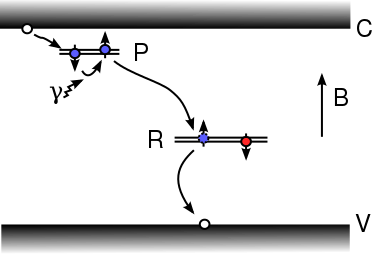Electrically detected magnetic resonance
Electrically detected magnetic resonance (EDMR) is a materials characterisation technique that improves upon electron spin resonance. It involves measuring the change in electrical resistance of a sample when exposed to certain microwave frequencies. It can be used to identify very small numbers (down to a few hundred atoms) of impurities in semiconductors.
Outline of technique

To perform a pulsed EDMR experiment,[1] the system is first initialised by placing it in a magnetic field. This orients the spins of the electrons occupying the donor and acceptor in the direction of the magnetic field. To study the donor, we apply a microwave pulse ("γ" in the diagram) at a resonant frequency of the donor. This flips the spin of the electron on the donor. The donor electron can then decay to the acceptor energy state (it was forbidden from doing that before it was flipped due to the Pauli exclusion principle) and from there to the valence band, where it recombines with a hole. With more recombination, there will be fewer conduction electrons in the conduction band and a corresponding increase in the resistance, which can be directly measured. Above-bandgap light is used throughout the experiment to ensure that there are lots of electrons in the conduction band.
By scanning the frequency of the microwave pulse, we can find which frequencies are resonant, and with knowledge of the strength of the magnetic field, we can identify the donor's energy levels from the resonant frequency and knowledge of the Zeeman effect. The donor's energy levels act as a 'fingerprint' by which we can identify the donor and its local electronic environment. By changing the frequency slightly, we can study the acceptor instead.
Recent developments
EDMR has been demonstrated on a single electron from a quantum dot.[2] Measurements of less than 100 donors[3] and theoretical analyses [4] of such a measurement have been published, relying on the Pb interface defect to act as the acceptor.
References
- Boehme, C.; Lips, K. (2003). "Theory of time-domain measurement of spin-dependent recombination with pulsed electrically detected magnetic resonance". Physical Review B. 68 (24): 245105. Bibcode:2003PhRvB..68x5105B. doi:10.1103/PhysRevB.68.245105.
- Elzerman, J.; Hanson, R.; Willems Van Beveren, L.; Witkamp, B.; Vandersypen, L.; Kouwenhoven, L. (2004). "Single-shot read-out of an individual electron spin in a quantum dot". Nature. 430 (6998): 431–435. arXiv:cond-mat/0411232. Bibcode:2004Natur.430..431E. doi:10.1038/nature02693. PMID 15269762.
- McCamey, D. R.; Huebl, H.; Brandt, M. S.; Hutchison, W. D.; McCallum, J. C.; Clark, R. G.; Hamilton, A. R. (2006). "Electrically detected magnetic resonance in ion-implanted Si:P nanostructures". Applied Physics Letters. 89 (18): 182115. arXiv:cond-mat/0605516. Bibcode:2006ApPhL..89r2115M. doi:10.1063/1.2358928.
- Hoehne, F.; Huebl, H.; Galler, B.; Stutzmann, M.; Brandt, M. S. (2010). "Spin-Dependent Recombination between Phosphorus Donors in Silicon and Si/SiO_{2} Interface States Investigated with Pulsed Electrically Detected Electron Double Resonance". Physical Review Letters. 104: 046402. arXiv:0908.3612. Bibcode:2010PhRvL.104d6402H. doi:10.1103/PhysRevLett.104.046402.